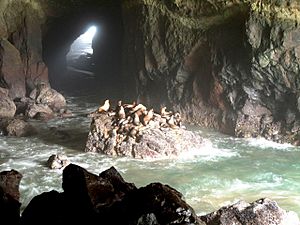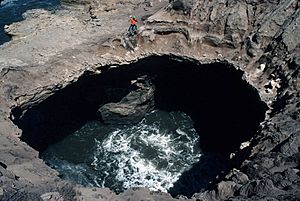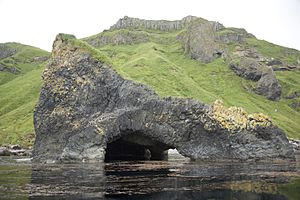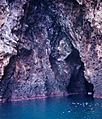Sea cave facts for kids

Sea caves are hollow spaces found in coastal cliffs. They are created by the powerful force of crashing waves. Other cool rock shapes like "sea arches" and "sea stacks" are also carved out of these rocky cliffs by the ocean. The sea constantly shapes the land, both by wearing it away and by dropping off sand and rocks. This process of the sea wearing away rock is called marine erosion.
How Sea Caves Form
Sea caves can form in many different kinds of rocks. These include sedimentary rocks (like sandstone), metamorphic rocks (like marble), and igneous rocks (like granite). Caves in stronger igneous rocks often grow larger because the rock is tougher.
For a sea cave to form, the rock cliff must have a weak spot. In strong rocks, this might be a crack called a fault or a dike (a sheet of rock that cuts through another rock). You can see this in the caves of the Channel Islands of California or the big sea caves on Kauai's Na Pali Coast in Hawaii. In softer sedimentary rocks, the weak spot might be a natural break between layers or where two different types of rock meet.
The main force that creates sea caves is the constant action of waves. Waves are always eroding rocky coasts. But where cliffs have weak zones, the rock wears away much faster. As the sea pushes into these cracks, they get wider and deeper. This happens because of the huge force of the waves themselves and any rock pieces they carry. Also, air gets trapped inside the cracks and gets squeezed by the waves. When the wave pulls back, the air expands quickly, which can blast pieces of rock away. Blowholes are a good example of this; they are partially underwater caves that shoot out big sprays of water as waves retreat.
Besides the water's force, the sand and rocks carried by the waves also grind away at the cliff. Most sea cave walls are rough and broken, showing how pieces of rock break off. But some parts of caves have smooth, rounded walls, often with rounded stones on the floor. This happens when the waves swirl these stones around, polishing the rock.
It's important not to confuse true sea caves with other types of caves. Some caves were formed inland and only became visible when the sea eroded the cliff back to them. Others are formed by water dissolving rock, especially in warm, tropical places. For example, in Halong Bay, Vietnam, caves in limestone are found near the sea. While the ocean helps make them bigger, they were originally formed by water dissolving the rock. These are sometimes called "hybrid caves."
Rainwater can also help form sea caves. Acids from rain and soil can seep into cracks and weaken the rock. Just like in other caves, small cave formations called speleothems can sometimes grow inside sea caves.
Sometimes, a sea cave can collapse, leaving a large hole called a "littoral sinkhole." Famous examples include Oregon’s Devil’s Punchbowl. Small pieces of land that stick out into the sea often have caves that go all the way through them, because waves attack them from both sides. If a sea cave tunnel collapses, it can leave a tall, free-standing rock column called a "sea stack" along the coast. Anacapa Island in California is believed to have split into three smaller islands because of this process.
Even living things can help enlarge sea caves! For instance, sea urchins can drill into the rock. Over many generations, they can remove a lot of rock from the floors and lower walls of the caves.
Images for kids
-
How a sea cave forms along a fault line on Santa Cruz Island, California, United States





